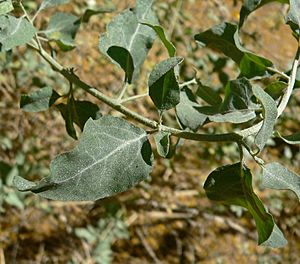Quail bush facts for kids
Quick facts for kids Quail bush |
|
|---|---|
 |
|
| Scientific classification | |
| Genus: |
Atriplex
|
| Species: |
lentiformis
|
| Subspecies | |
|
A. lentiformis ssp. breweri (S.Wats.) Hall & Clements (quailbush) |
|
| Synonyms | |
|
(?) Obione lentiformis Torr. |
|
Atriplex lentiformis is a type of saltbush plant. People call it by many names, like quail bush, big saltbush, quailbrush, and lenscale.
Contents
Where Quail Bush Lives
The quail bush grows naturally in the southwestern United States and northern Mexico. It likes to live in places where the soil is salty or alkaline. You can find it in salt flats, dry lake beds, and along coastlines. It also grows in desert areas. Sometimes, it can even be found on riverbanks and in woodlands where the soil is not salty.
What Quail Bush Looks Like
The quail bush is a large, spreading shrub. It can grow from one to three meters (about 3 to 10 feet) tall. It often spreads out even wider than it is tall. This plant has many branches. Its leaves are gray-green and can be up to 5 centimeters (about 2 inches) long. The edges of the leaves might be toothed or wavy.
How Quail Bush Reproduces
Some quail bush plants have only male or only female flowers. Other plants can have both male and female flowers on the same plant. The male flowers grow in long, thin groups up to 50 centimeters (about 20 inches) long. The female flowers grow in smaller, tighter groups. What's cool is that a plant can even change from having only male flowers to having only female flowers, or vice versa! This plant usually blooms in June and July.
Uses of Quail Bush
Quail bush is an important plant for some animals. For example, the saltbush sootywing butterfly, called Hesperopsis alpheus, eats this plant.
People also use Atriplex lentiformis to help bring natural areas back to health. This is called restoration. It is one of the native plants used in projects to restore riverbank areas in its home regions.
Quail Bush in River Valleys
The quail bush grows well in the Lower Colorado River Valley and Gila River valleys. These areas are in southwestern Arizona, southeastern California, and northwestern Mexico. Here, it often grows with other native plants like Arrowweed and Velvet mesquite.
Quail bush grows tallest where there is plenty of water from underground. It also thrives in salty soil, which helps it compete against other plants. However, some invasive species like Tamarisk and tumbleweed can be tough competitors. In good growing spots, the quail bush can reach about 3.5 meters (11.5 feet) tall and wide. It can form large, rounded shapes that merge together, creating thick, dense areas.

